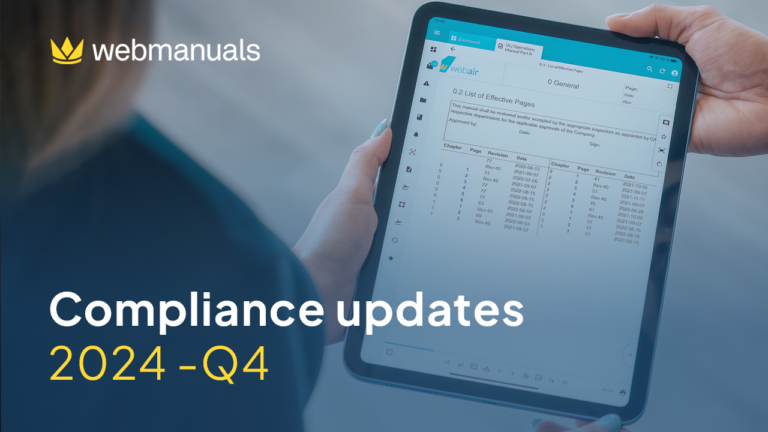
Web Manuals’ chief revenue officer and director of operations EMEA Paul Sandström assesses how to keep up with the changing cargo regulations brought about by Covid-19, Brexit and other factors.
This year is set to be much the same as 2020, with ongoing turmoil for the aviation community. The Covid-19 pandemic caused global flight groundings.
As I write this in early 2021, further travel restrictions and border closures are in place. As the continued disruption put financial and operational pressure on airlines and their partners, regulators implemented measures to support operators through the crisis.
How has airline cargo been affected so far?
Air cargo, a crucial part of the supply chain, has been central to delivering medicines, medical equipment and other vital goods throughout the pandemic. Utilising cargo capacity onboard airlines was an important component in this, making the most of severely reduced passenger demand.
As a result, the International Air Transport Association (IATA) has been collaborating with the International Civil Aviation Organization (ICAO) and other regulatory bodies to ensure air cargo supply chains remain open.
These organisations are working with the World Customs Organisation (WCO) to minimise border blockages for humanitarian goods. Country-specific information is online, with customs information and actions to be taken. In addition, the European Commission has issued guidelines on facilitating air cargo operation during Covid-19.
The UK also left the European Union and, as a result, withdrew from the European Aviation Safety Agency (EASA). That meant the UK’s responsibility for safety regulation and new aircraft type certification transitioned to the Civil Aviation Authority (CAA). With that came more disruption and an overhaul of regulatory documentation for those flying into and out of the country, with many operators now having to ensure they comply and have the correct paperwork for more than one aviation authority.
While having access to current guidelines and constraints is incredibly helpful in enabling airline cargo operators to understand the changing regulations, these documents need to be managed in a way that ensures compliance and allows the right people easy access and to take action without delay.
Of course, it isn’t just cargo that has been impacted by changing regulations; other aviation sectors have also faced temporary and adapted regulations in 2020. For example, the use of commercial drones grew massively during the pandemic as they were used to transport food, medicine and essential goods to those unable to leave their homes.
To manage the regulation of drones, the Federal Aviation Authority (FAA) awarded hundreds of Part 107 waivers to drone operators and organisations in the first quarter of 2020. For a limited time, these waivers allowed companies to operate drones outside of the usual rules, such as flying outside of daylight, above 400ft or without three miles of weather visibility.
Since 31 December 2020, the Commission Implementing Regulation (EU) 2019/947 – also known as the new EASA drone regulation – came into effect. This and other related rules form a larger, inclusive regulatory framework to ensure safe, secure and sustainable drone integration across Europe.
Changing cargo regulations for 2021
So, what changing regulation revisions can air cargo operators expect in 2021?
Cargo operations manuals have been revisited for 2021, with revisions to the ULD regulations (ULDR), IATA Cargo Handling Manual (ICHM) – which features requirements for maintaining distance, disinfecting GSE and using drop zones (cargo on ramp) to avoid cross- contamination – and a new IATA manual on how to prepare, ship and handle human remains known as the Compassionate Transportation Manual (CTM).
Amongst additional changes involving the Live Animals Regulations (LAR), Perishable Cargo Regulations (PCR) and Temperature Control Regulations (TCR), the Dangerous Goods Regulations (DGR) has seen updates take effect from 1 January 2021 relating to the implementation of competency-based training and assessment for dangerous goods and the addition of new special provisions. The Lithium Battery Shipping Guidelines (LBSG) have been amended to require the approval of the authority of the state of the operator in addition to the authority of the state of origin.
Finally, the Airport Handling Manual (AHM) and IATA Ground Operations Manual (IGOM) have both seen a number of changes as a result of Covid-19, including those in relation to new training requirements, the transportation of cargo in the cabin and aircraft cleaning.
With so many new requirements in 2021, which will all need to be cross-referenced and relayed to all of those it impacts with mandatory training managed and logged, compliance managers will have a significant job on their hands. This is especially true if they are currently operating with reduced resources or time constraints and have to deal with the possibility of regulations regularly changing throughout the year as we adapt to the new aviation environment.
How to manage changing cargo regulations effectively
Due to many factors – Covid-19 and Brexit included – the regulations ‘jungle’ is getting thicker and constantly evolving. Managing the increased complexity of multiple regulators whilst staying diligent and efficient – especially if you are used to only monitoring one – is a challenge. So, how can these changes be effectively managed, especially when the future still has so many unknowns?
I have always been an advocate for going digital. As we witnessed during 2020, working remotely and conducting business virtually has its benefits. Time has been saved and people have been using a range of digital tools to communicate, collaborate and organise. When it comes to regulatory documentation and aviation manuals, digitising means that all the information you need is in one place and can be instantly updated and shared around an organisation, no matter where you are in the world.
Regulation changes are automatically updated within the digital regulation libraries. With a digital compliance monitoring process, there is no longer a need to copy and paste changed regulations into Excel sheets. A digital compliance monitoring process also enables operators to know which operational processes have been affected by changing cargo regulations.
This reduces the administrative burden of comparing regulation versions and updates, while at the same time reducing the risk of human error from inputting information. Even if staff levels are reduced, an automatic, efficient digital system allows businesses to stay abreast of changing cargo regulations and keep crews updated.
As our community continues to face an uncertain and complex future, protecting the safety of staff, crew and customers is paramount. With airline cargo playing such an important role in supporting millions of people worldwide through the transportation of medicines, food and other essential items, it is important to remain on top of any changing cargo regulations to ensure safety and the continuation of the industry through this tough time.
Digitalisation offers a way of managing the changing cargo regulations, in an efficient and time-saving manner, freeing up the time of compliance managers to focus on additional business growth activities crucial to continuing to support those who need deliveries worldwide.




